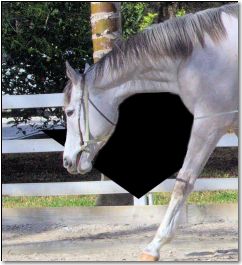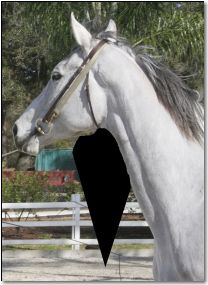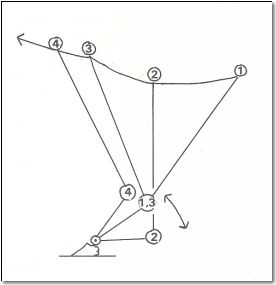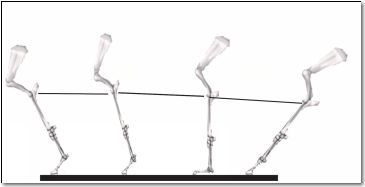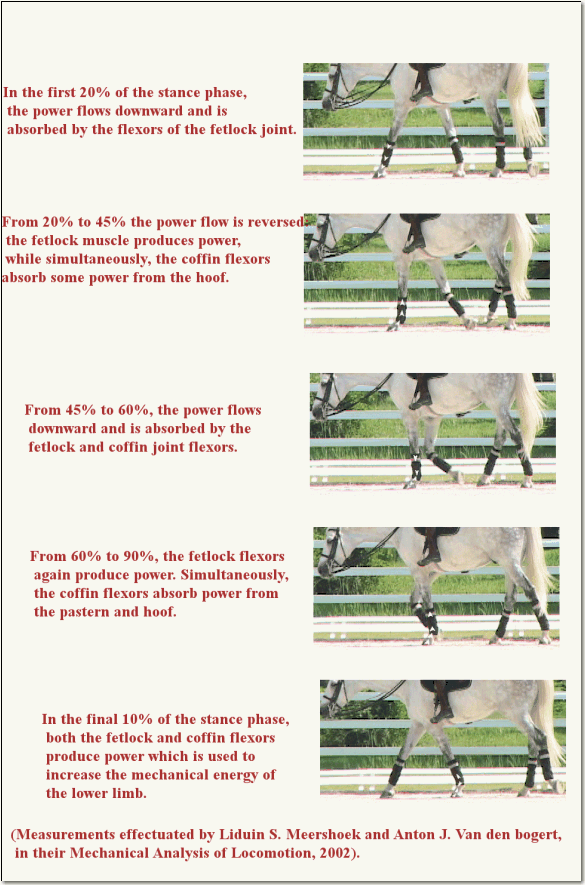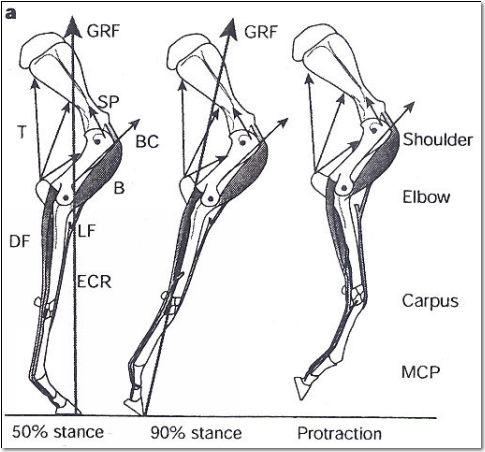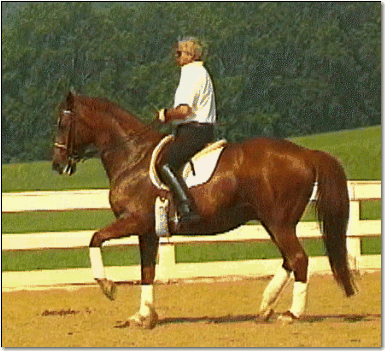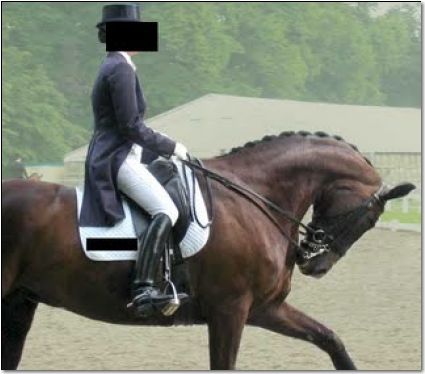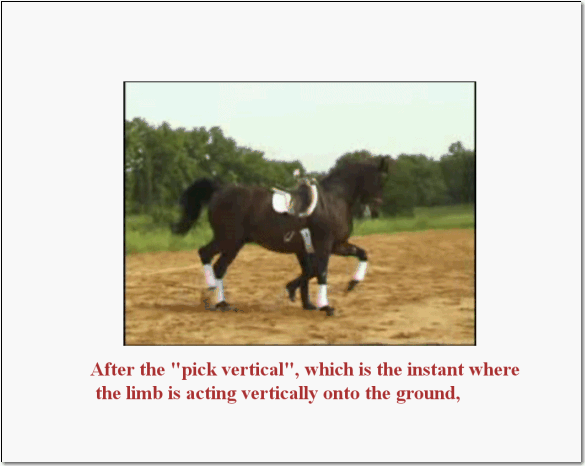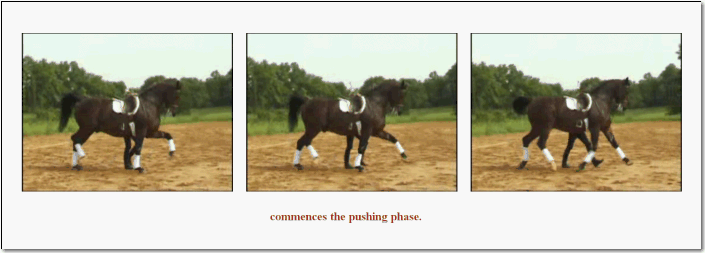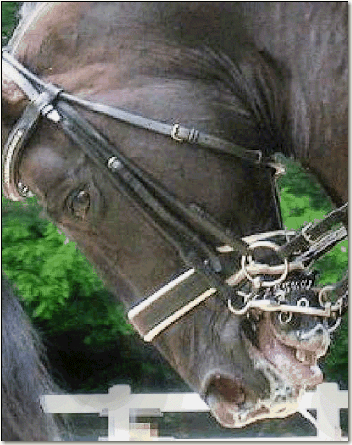Hyperflexion of the Neck
A failure of Olympic dimension
Part III
Increased weight on the forelegs
The horse’s head weighs approximately 10% of the horse’s body weight. Therefore, a 1200 pounds athlete carries 120 pounds at the end of his neck. The burden lessens as the head is carried high approaching the verticality of the shoulders. By contrast, the burden increases as the neck is held in a longer position.
The black arrow illustrates the attraction of gravity
In the nineteen Century, this simple law of physics prompted the Prussian Cavalry to promote the total elevation of the neck. Starting in 1825, the horse’s neck and head were held in an upright position. The experiment lasted several decades and then, when the damaging effects of the neck posture on the horse’s back overwhelmingly disproved the theoretical gain of balance, the technique was abandoned.
By contrast, the Prussian Emperor’s riding Master, Paul Splinzner (1853-1920),
lowered and over-flexed his horse’s neck completely.
Hyper-flexion of the neck is not a new concept. From Splinzner’s days to actual rollkur, the horse’s neck and head went up and down as one fashion succeeded to the other. While on the east side of the Rhine River, Splinzner lowered and over-flexed his horse’s neck, Francois Baucher (1776-1873) on the west side
promoted in his “Dernier Enseignements” (last teaching): the systematic elevation of the neck. Decades later, Etienne Beudant (1863-1949) rode his horses with the poll the higher point of the neck but occasionally practiced the “ramener extreme,” in which the author over-flexed his horses’ neck “until the horse’s chin almost touches his breast”. Years later, in his “Equitation Raisonee,” (1951) Jack Licart practiced the “extension”
of the neck introducing the concept of stretching. In the French language, “extension” does have a meaning of elongation and stretching. In reality, the lowering of the neck is a flexion created by concentric contraction of
the lower neck muscles. In 1973, Harry Bolt warned against the practice of over-flexing the horse’s neck. Today, hyper-flexion of the horse’s upper neck is viewed as a winning recipe.
Curiously, whether the neck was held in a high or low posture, the theoretical effects were invariably the same: suppleness, stretching, and greater hind-leg engagement. The rationale may be that the positive results obtained with either neck posture were due to the rider’s skill and the horse’s talent rather than, or even perhaps in spite of the neck position.
The thought behind the total elevation of the head and neck was to reduce the weight burden of the head and neck on the forelegs. Strangely, the concern that the weight of the head and neck loads the forelegs does not apply to the theories promoting a lowering of the neck. Perhaps the omission is strategic; it is best to avoid a discussion of a problem when one does not want to know the answer. Maybe in the proponent’s mind, the thought that the lowering of the neck stimulates greater engagement of the horse’s hind legs cancels the
loading effect of the head and neck on the forelegs.
In contrast with the thought that the hind legs are propelling the horse into lightness, technologies that our predecessors did not have, demonstrate that the forelegs, rather than the hind legs, produce the greatest percentage of upward propulsive force. “In horses, and most other mammalian quadrupeds, 57% of the vertical impulse is applied through the thoracic limbs, and only 43% through the hind limbs.” (H. W. Merkens, H. C. Schamhardt,G. J. van Osch, A. J. Van den Bogert, 1993). Hence, loading the forelegs does hamper
the horse’s ability to move forward and perform soundly and efficiently.
In 1969, James Rooney illustrated the kinematics of the forelegs by demonstrating how the forelegs produce an upward propulsive force. Each line of the original drawing represents a segment of the forelimbs, pastern, fetlock, etc. For clarity, we replace the lines with real bond structures. The result demonstrates how the forelegs produce upward propulsive forces.
At the walk, the horse’s limbs primarily act as levers (inverted pendulum), pushing the horse’s body forward. At the trot, they act like springs. The canter combines both a pendulum and bouncing action. “In inverted
pendulum gaits like walk, the limbs act as rigid struts over which the body vaults. In the bouncing gaits like trot, the limbs act as a spring and the body center of mass moves like a bouncing ball. Equine gallop might have both
bouncing and pendulum aspect.”(Mechanical Analysis of Locomotion, Liduin S. Meershoek and Anton J. Van den Bogert, 2002).
The spring metaphor is not about a spiral-like structure compressing and rebounding, but rather the work of elastic structure; like tendons and ligaments that store energy when they elongate. The energy is
released when they return to their normal length. “The muscular work of galloping in horses is halved by storing and returning elastic strain energy in spring-like muscle-tendon units. These make the legs actl
like a child’s pogo stick that is tuned to stretch and recoil at 25 strides per second.” (Alan M. Wilson, M. Polly McGuigan, Anne Su, Anton J. Van den Bogert, Horses Damp the Spring in Their Step, 2001) The spring of a child pogo stick is designed to rebound optimally when compressed under the average weight of a child. If a large
adult plays with a child’s pogo stick, the spring will be compressed beyond its structural efficiency and the elastic recoil will be markedly reduced. Likewise, increased weight on the front limbs will markedly alter the forelegs’
capacity of elastic recoil.
The complexity of the system underlines its vulnerability to weight increase. For instance, if one concentrates on the fetlock and coffin joint only, a sophisticated network of power absorption and power production occurs.
From the fetlock, all the way to the muscles supporting the trunk from the front legs, the whole structure is designed to store and return elastic strain energy. For instance, the biceps muscle-tendon system stretches as the forelimb upon ground contact moves backward. At 90% of the support phase, when the heel lifts up and the hoof clears the ground, the biceps muscle-tendon system catapults the front leg forward.
GRF: Ground Reaction Force – SP: Supraspinatus – BC: Brachiocephalicus – B: Biceps – LF: Lacertus fibrosis – ECR: Extensor carpi radialis – DF: Digital flexor – T: Triceps. “Horses cannot achieve the high power output required for rapid limb protraction by simple muscle contraction and they instead deploy an elastic biceps muscle to store and then release burst of energy. This muscle’s catapult action has an output that is comparable to over 100 times its mass of non-elastic muscle.” (Alan M. Wilson, Johanna C. Watson, A Catapult Action for Rapid Limb Protraction, 2003.)
This catapult system creates the elevation of the knees during the piaff.
Several years ago trainers attempted to create artificial elevation of the knees during piaff by hitting the horse’s front legs with a bamboo pole. This is an example of practices that are designed to cover the flaws of inefficient
training techniques. Such practices are failure of Olympic dimensions. Instead of using actual knowledge of equine physiology to optimize the elastic strain energy of the forelegs, trainers dusted the bamboo
pole from the jumper’s attic, condemning extraordinarily talented horses to performances below their potential.
The forelegs are designed to recoil optimally to a given weight. Influencing the kinematics of the hind legs and the biomechanical properties of the horse’s vertebral column, riders have the capacity to regulate the weight loading the forelegs. This can be done by adapting the riding techniques to an actual understanding of the equine vertebral column mechanism. Neck postures that load the front limbs alter proper mechanism
of the forelegs, and consequently, the horse’s gaits and performance. In this matter, the hyper-flexion of the neck combined with a low neck posture, which is the Rollkur approach, increases the load on the forelegs.
During the support phase, which describes the time the hoof is on ground contact, the front hoof exerts first on the ground a force in the direction of the motion. This sequence of the stride is referred to as the “braking phase” and lasts from alighting until approximately 40% of the support phase. After peak vertical, which is the instant
where the front leg is acting vertically onto the ground, the front hoof exerts on the ground a force in a direction opposed to the direction of the movement. This sequence of the stride is referred to as the “ pushing phase”.
The term “braking” is a little confusing. Perhaps a better world would be “shock-absorbing phase”. During this sequence, the joints, ligaments, tendons, and muscles of the forelegs absorb the impact forces. The forelegs’ capacity to produce vertical impulse is mostly produced during the pushing phase. While measurements estimate that the braking phase lasts during the initial 40% of the time the hoof is on the ground and the pushing phase lasts the next 60%, variables occur in regard to the situation and the demand. If the body situation is increased weight on the forelegs, the horses may increase intensity and duration of the braking phase. When a horse exhibits a trot that is fast, flat and without suspension, with a seemingly four-beat trot wherein the forelegs move faster than the hind legs, the braking activity of the forelegs is increased, and consequently, the propulsive activity is decreased.
On the upcoming video, “From Mediocre Gaits to World Class Movement” this is exactly the situation that led an 18.1 hand horse to exhibit a mediocre trot. The horse became an extraordinary mover when it was possible to reduce the weight loading the forelegs. Instead of opposing the braking activity of the forelegs with the propulsive
activity of the hind legs, the horse gained balance control and outstanding gaits, thereby increasing the propulsive activity of the forelegs. The horse in question is the horse executing medium trot in hand on the introductory page of our website.
It was possible to diminish the weight loading the forelegs, avoiding any neck posture that could have increased the load on the forehand, and developing the biomechanical properties of the horse’s vertebral column. How such education was achieved is beyond the scope of this discussion and is fully explained in the upcoming DVD.
Just as the use of bamboo pole tried to save appearances when the training technique failed to properly coordinate the horse’s physique for the effort, the hyper-flexion of the neck denies the horse the opportunity of being properly educated for the performance. The abuse is about control. The horses are often extraordinary athletes, but the riders have not kept up with the evolution in education, so they demand submission
of their horses, while inducing strain in an area of the neck that does not have the capacity to support strain.
The riders’ skills are undeniable, but the techniques applied demean the horses’ talents and jeopardize soundness.
Breakdowns occur when repetitious abnormal stresses are loading the forelegs.
A recent study on human newborn babies has explored the relation between facial expression and physical pain. Like horses, babies do not have many ways to express discomfort or pain. The common denominator of every facial picture of horses working in hyper-flexion of the neck is distress and discomfort
.
It would be gravely unethical to consent that horses should suffer for the good of the rider’s ego. The thought becomes intolerable when one realizes that there is no athletic advantage of working the horses in such restraint.
It is extremely unfortunate that instead of exploring a more advanced form of equitation optimizing the horses’ talent through subtle orchestration of their vertebral column’s properties, otherwise skilled riders have elected to reactivate a technique of the nineteen century in order to subdue extraordinarily gifted horses. Even if intense lobbying attempts to make hyperflexion of the horse’s upper neck looks like progress, the approach is a draw back. It retrogrades the equestrian education back a century. Whatever one looks at it from the perspective of the equine physiology, from an aesthetic point of view, or from the perspective of human ethic, the concept of gaining control exploiting a weak part of the horse’s physique is ugly.
Jean Luc Cornille©2009

